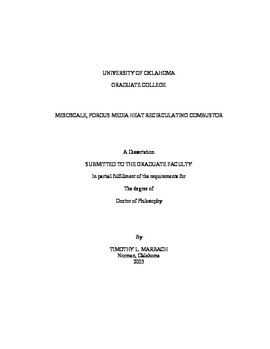| dc.contributor.advisor | Agrawal, Ajay K., | en_US |
| dc.contributor.author | Marbach, Timothy L. | en_US |
| dc.date.accessioned | 2013-08-16T12:19:53Z | |
| dc.date.available | 2013-08-16T12:19:53Z | |
| dc.date.issued | 2005 | en_US |
| dc.identifier.uri | https://hdl.handle.net/11244/902 | |
| dc.description.abstract | Small-scale power generation systems offer an alternative to traditional batteries because of the high energy density of hydrocarbon fuels. Combustion at small scales presents several challenges, including high heat loss and short flow residence times. Heat recirculation is an effective method to limit heat loss and improve combustion performance. However, new methods of achieving heat recirculation in a small volume must be developed for practical devices. To meet this requirement, a heat recirculating, lean premixed combustion system utilizing porous inert media (PIM) has been developed. Combustion with the use of silicon carbide PIM was investigated experimentally with the flame stabilized above the surface and within the interior of the PIM. The two flame stabilization locations were directly compared at identical conditions. The interior combustion mode extended the lean blowoff limit, allowing for reduction in NOx pollutant emissions. The combustion and heat transfer characteristics of the mesoscale, heat recirculating combustor design were determined experimentally with a system of 125 cm3 using methane fuel. The combustor featured an annulus around the combustion chamber to preheat reactants and reduce heat loss to the surroundings. The presence of PIM in the preheating annulus and exterior surface insulation improved combustion performance by increasing reactant preheating and reducing heat loss to the surroundings. Computational fluid dynamics (CFD) analyses were used to characterize heat transfer and to identify sources of heat loss. Axial conduction through the combustor wall and radiation across the preheating annulus were the two primary sources of heat loss. Design modifications aimed at reducing heat loss and improving system performance were analyzed. The most effective design improvements were a low thermal conductivity lid and a radiation shield in the preheating annulus. A phase II mesoscale, heat recirculating combustor design, based on the CFD analyses, was developed. Increasing reactant flowrate and increasing the size of the combustor reduced heat loss to the surroundings. Thermal performance of the phase II combustor design was demonstrated experimentally with an overall system volume of 1.5 cm3. Heat release rates exceeded 90 W, heat loss was less than 13% of the heat release rate, and combustion efficiency was greater than 99%. The findings of this work will be useful in guiding small scale combustor designs and advance mesoscale combustion toward practical implementation. | en_US |
| dc.format.extent | xix, 258 leaves : | en_US |
| dc.subject | Combustion Research. | en_US |
| dc.subject | Porous materials. | en_US |
| dc.subject | Engineering, Mechanical. | en_US |
| dc.subject | Heat of combustion. | en_US |
| dc.title | Mesoscale, porous media heat recirculating combustor. | en_US |
| dc.type | Thesis | en_US |
| dc.thesis.degree | Ph.D. | en_US |
| dc.thesis.degreeDiscipline | School of Aerospace and Mechanical Engineering | en_US |
| dc.note | Adviser: Ajay K. Agrawal. | en_US |
| dc.note | Source: Dissertation Abstracts International, Volume: 66-05, Section: B, page: 2788. | en_US |
| ou.identifier | (UMI)AAI3176315 | en_US |
| ou.group | College of Engineering::School of Aerospace and Mechanical Engineering | |
